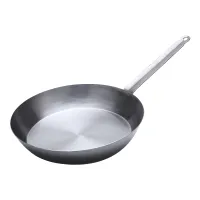How do I choose a frying pan for healthy eating?
Selecting the right frying pan is a crucial step in promoting healthy eating, as it can influence the nutritional quality of your meals. Consider the following factors to ensure that your choice of frying pan aligns with your health-conscious cooking goals:
**1. Material Matters:
Stainless Steel: Durable and resistant to corrosion, stainless steel pans are a healthy choice. They don't react with acidic or alkaline foods, preserving the natural flavors of your ingredients.
Cast Iron: Known for even heat distribution, cast iron pans can add a dose of iron to your diet. They require proper seasoning to maintain a non-stick surface.
Ceramic: Ceramic-coated pans provide a non-stick surface without the potential health concerns associated with traditional non-stick coatings. Look for those free from PFOA and PTFE.
**2. Non-Stick Considerations:
Avoid PFOA and PTFE: Traditional non-stick pans often contain PFOA and PTFE, which may release harmful fumes when heated at high temperatures. Opt for pans labeled as PFOA and PTFE-free to minimize potential health risks.
Ceramic or Titanium Coating: Consider non-stick pans with ceramic or titanium coatings as healthier alternatives. These coatings are generally more resistant to scratching and do not emit harmful fumes.
**3. Size and Depth:
Portion Control: Choose a frying pan size that suits your typical meal portions. Using a smaller pan can help with portion control and encourage healthier serving sizes.
Deeper Pans: Pans with higher sides are versatile for various cooking methods, including stir-frying and sautéing. They also reduce the risk of spills and splatters.
**4. Heat Conductivity:
Even Heat Distribution: Look for frying pans with even heat distribution to prevent hot spots. This ensures that your food cooks uniformly and helps you avoid the need for excessive oil or fat.
**5. Handles and Grips:
Cool-Touch Handles: Opt for pans with handles designed to stay cool during cooking. This feature enhances safety and reduces the risk of burns.
Ergonomic Design: Comfortable, ergonomic handles make it easier to maneuver the pan, especially when flipping or tossing ingredients.
**6. Compatibility with Cooking Surfaces:
Induction Compatibility: If you have an induction cooktop, ensure that the frying pan is compatible with this type of cooking surface.
Oven-Safe: Choose a frying pan that is oven-safe if you plan to use it for recipes that involve both stovetop and oven cooking.
**7. Maintenance and Cleaning:
Dishwasher-Safe: Consider the ease of cleaning when choosing a frying pan. Dishwasher-safe options can simplify the cleaning process, but handwashing is often recommended for preserving the longevity of certain coatings.
**8. Brand Reputation and Reviews:
Research Brands: Explore reputable brands known for producing high-quality cookware. Reading customer reviews can provide insights into the performance and durability of specific frying pans.
**9. Budget Considerations:
Balancing Quality and Cost: While investing in a high-quality frying pan is beneficial, it's essential to find a balance between quality and budget. Look for pans that offer good value for their features and durability.
Choosing a frying pan for healthy eating involves considering the materials, non-stick features, size, and other practical aspects. By selecting a pan that aligns with your health-conscious cooking preferences and culinary needs, you can enjoy delicious and nutritious meals without compromising on taste or quality.



